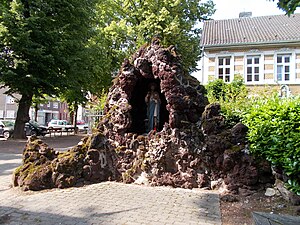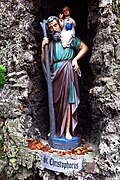Hehner Grottoes
The Hehner caves are in the district Hehn in Mönchengladbach (Nordrhein-Westfalen), Holy Pesch 81b. They are part of the pilgrimage site of St. Mary's Visitation Hehn-Heiligenpesch, which has been attracting pilgrims since the 16th century. The tufa grotto was built between 1894 and 1895. It consists of three grottos: the Rochus grotto, the Lourdes grotto and the grotto of the 14 Holy Helpers.
The extraordinary building ensemble has been a listed building since June 2, 1987. It was entered in the monuments list of the city of Mönchengladbach under No. H 036 .
history
A holy grotto in Hehn is mentioned in the church chronicle as early as 1883. In it stood a figure of the Virgin Mary and the statue of Rochus from the Lady Chapel , which was demolished in 1870. The records are silent about where exactly. It was probably located near the healing spring at the Rochus grotto. Nothing is left of her today.
Today's cave complex from the years 1894 and 1895 owes its construction to the pastor Theodor Jöbges. Due to the culture war in the empire with the strict separation of state and church, the number of visitors to the pilgrimage site sank drastically. In order to make the pilgrimage more attractive again, it was decided to build the multi-part grotto with the figures of saints.
First, in 1894, with the permission of the Vicar General of Cologne, the Rochus Grotto was built next to the Heiligenpesch Chapel and the Lourdes Grotto behind the church. A year later, the large accessible grotto of the 14 helpers followed.
In 1983 the cave complex was completely renovated.
architecture
For the diocese of Aachen , even for the entire Lower Rhine, the Hehner grottoes are unique in their shape. Normally one would expect such a pilgrimage site to be in Bavaria. The grottos, here as artificial caves, come from the garden art of the Renaissance and Baroque and are decorated with rock and shell work. They are of different sizes and heights. The largest, the grotto of the 14 helpers in need, is even accessible via stairs. The figures of the saints are made of terracotta and are very popular.
The Rochus Grotto
Near the Chapel of Mercy, to the left of the main portal of the Church of the Visitation of the Virgin Mary , is the grotto of Saint Roch of Montpellier. The patron saint for cattle was venerated by the farmers. As a pilgrim, he fits in well with the pilgrimage site. In the past, a spring originated here that was considered to be medicinal for eye ailments and other diseases. As the pastor noted, it was also used by people of other faiths. The water point is now sealed.
The figure of Saint Roch with a walking stick and dog was created by the Gladbach artist Fritz Högen (1862 - 1930). It cost the Marienbauverein an impressive 125 marks. At that time the sum was more than double the monthly earnings of a weaver in the Rhineland. The materials for the cave construction were supplied by the Elber and Herx company from Mönchengladbach.
The Lourdes grotto
The Lourdes grotto in Hehn was built in 1894 with the permission of the Cologne Vicariate General. Over the years, their appearance and location have changed. It was last completely renovated in 1983. It recreates the apparition of the Mother of God in Lourdes and how she met the godly Bernadette. The girl praying in the small side grotto is often associated with Saint Anne .
In the large cave below, five stones from the Lourdes grotto were embedded in order to strengthen the power of the holy place. Of them, however, only three are left. On a small pedestal in a shrine there is a 45 cm high copy of the Infant Jesus of Prague . The original of the Infant Jesus from the 16th century is in the Carmelite Monastery in Prague . Numerous intercessory tablets and souvenirs testify to the veneration of saints.
The grotto of the 14 emergency helpers
The grotto of the fourteen emergency helpers was completed in 1894. It is the largest and most impressive grotto on Heiligenpesch. The artificial rock hill is accessible via the two stairs. There are statues of holy women and men in 14 niches along the stairs. There is a crucifix with Jesus on the top . This was very unusual, as the veneration of the 14 helpers in need is widespread especially in southern Germany, while the Rhinelander turned to the Holy Mother with worries and needs. This is reflected in the Pietà in the grotto below the gallery. The mourning Mary with her deceased son on her lap is, so to speak, the "15th Emergency helper ”.
Pastor Theodor Jöbges chose the 14 emergency helpers to remind the pilgrims that in the Catholic faith there is a personal advocate for every injustice. They are a testimony to popular piety and, through their life story, show the acceptance of unchangeable fates and give comfort in difficult situations.
The statues of the saints with their attributes are made of terracotta and are typical works of folk art. Little is known about their origins.
See also
swell
- Official website of the pilgrimage church of St. Mary's Visitation Hehn (grotto complex)
- on the go & at home - homepage of Käthe and Bernd Limburg - monuments in the city of Mönchengladbach
- Talk-About-us e. V. - The Hehner Grottoes and the following pages
- Ökomenisches Heiligenlexikon - Fourteen Holy Helpers in Need
- Paul Clemen - The art monuments of the Rhine province. Third volume, No. IV, Schwann-Verlag, Düsseldorf 1893, in archive.org
Individual evidence
- ↑ Monuments in the city of Mönchengladbach - No. H 036, grotto in Hehn. In: on the way & at home - homepage of Käthe and Bernd Limburg. Retrieved June 6, 2018 .
Coordinates: 51 ° 10 ′ 47.9 " N , 6 ° 22 ′ 21.1" E

















